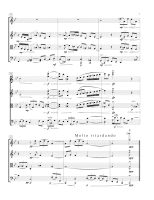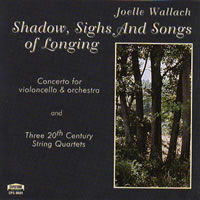String Quartet #2 [13']
String Quartet #2 takes its stark epigram from Yeats’ The Circus Animals’ Desertion:
…Now that my ladder’s gone,I must lie down where all the ladders startIn the foul rag and bone shop of the heart.
The work was conceived and composed in the aftermath of the composer’s husband’s sudden, untimely death. As the Yeats lines suggest, the quartet’s four movements explore intense sensibilities and subtle interactions among players through touching, unpretentious melodies which are presented in simple yet profoundly poignant ways.
The Quartet consists of four movements or moods. The first is nostalgic, declarative, almost sweet. Each instrument alternately sings part of the melodic line and plays other melodic fragments against it. The second movement is angry, angular yet again clearly melodic with the instruments this time almost always move in parallel. They rage against one another while driven closely together.
In the third movement, the viola sustains a plaintive melody almost all the time, with the other instruments providing an eerie harmonic background. Although the harmonic motion seems strangely static, it inexorably, very gradually almost imperceptibly stretches toward unexpected tonal centers.
The fourth movement is brisker. Yet it too has a craggy insinuated melancholy. Here the instruments frequently play in pairs, breaking off and abandoning the solitary viola to play alone, exploring cadenzas which seem to contemplate the music that’s gone before.
In his review for The New Music Connoisseur Mark Greenfest wrote:
“String Quartet #2 has a romantic intensity with a Webernian clarity. Her voice has the strength of Bartok (or Beethoven) – passionate, articulate, authentic and thoroughly moving.”
“String Quartet #2 is a distilled reflection on sorrow and grief. It does not seek to expose or enact the emotions of grief nor the psychological landscapes of sorrow. Instead through strictly musical processes, it reflects on that landscape by presenting the same thematic ideas through four lens or moods. Wallach’s ability to abstract from experience and distill it into such a brilliantly wrought work is miraculous. The composer’s exploration of string textures, contrasts, thematic variations and structures becomes inseparable from the widow’s reflections on loss through the frames and lens of distinct moods.”
—Don Mager, Making Time, Eclectica.org July/Aug 2002
Shadow, Sighs and Songs of Longing: Music for Strings including
String Quartet #1
String Quartet #2
String Quartet #3
Shadow, Sighs and Songs of Longing, a concerto for cello and orcehstra
Featuring the Meridian Quartet, and the National Slovak Radio Orchestra, Joel Suben conductor and Robert DeMaine, cello soloist.




